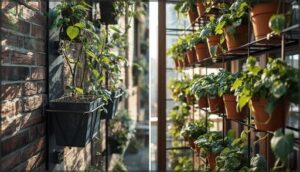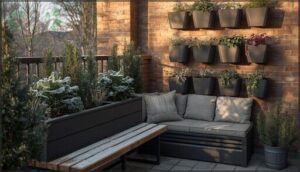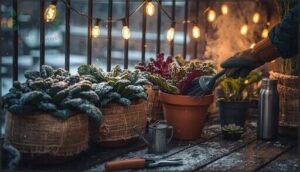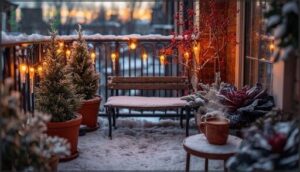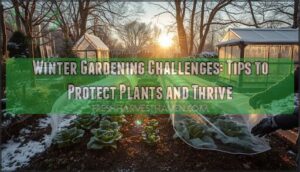This site is supported by our readers. We may earn a commission, at no cost to you, if you purchase through links.
You don’t need a sprawling backyard to keep your hands in the soil when frost arrives. A six-by-eight balcony can host winter salad greens, a sunny corner near your front door can cradle cold-hardy herbs, and a narrow strip along a fence can become home to evergreens that shrug off snow.
Small spaces actually work in your favor during winter—they’re easier to shelter from harsh winds, simpler to cover when temperatures plunge, and you can focus your energy on a few well-chosen plants instead of maintaining acres.
The secret isn’t fighting your space limitations; it’s learning to garden vertically, choose plants that thrive in the cold, and make every square foot count.
Table Of Contents
- Key Takeaways
- Planning Your Winter Garden in Small Spaces
- Selecting Plants for Winter Interest
- Maximizing Space With Vertical and Raised Beds
- Essential Winter Garden Maintenance
- Enhancing Beauty and Function in Winter Gardens
- Frequently Asked Questions (FAQs)
- What is the 70/30 rule in gardening?
- What is the rule of 3 in gardening?
- What do you plant in your garden in the winter time?
- What is the gardening 3 year rule?
- How to create a Winter Garden in a small space?
- Are Winter Garden ideas a good idea?
- How can garden structures help a small winter garden?
- What makes a beautiful winter garden?
- How do you take care of a small garden in winter?
- How can a garden survive winter?
- Conclusion
Key Takeaways
- Small spaces actually work to your advantage in winter gardening because they’re easier to shelter from wind, simpler to cover during temperature drops, and let you concentrate resources on fewer well-chosen plants instead of spreading yourself thin across larger areas.
- Success hinges on mapping your microclimate first—even tiny balconies have temperature variations of 5°F or more between sunny walls and frost pockets, and understanding these zones determines which plants will actually thrive versus just survive.
- Vertical structures like trellises and raised beds can triple your growing capacity in tight quarters, with insulated raised beds running about 9°F warmer than ground-level soil and vertical plantings maximizing every square inch of wall space.
- The 70/30 rule creates year-round interest by dedicating 70% of your space to reliable structural plants like cold-hardy evergreens and perennials, while reserving 30% for seasonal experimentation with winter vegetables and frost-tolerant herbs.
Planning Your Winter Garden in Small Spaces
Winter gardening in tight quarters isn’t about squeezing plants into random corners—it’s about working smarter with what you’ve got. Before you order a single seed or move a pot, you need to understand your space, your climate, and what’ll actually grow through the cold months.
Winter gardening in small spaces demands strategic planning—understand your microclimate and plant choices before you start
Here’s how to lay the groundwork so your winter garden thrives instead of just survives.
Assessing Space and Microclimate
Before you sketch a single bed, you need to map your small garden and decode its microclimate zones. Walk your space at different times—noting temperature gradients, wind shelter spots, and elevation effects. South-facing walls? Prime real estate for heat-lovers. Frost pockets in low corners? Flag those for cold-hardy picks. Even tiny balconies have unique microclimates worth studying. Understanding local microclimate conditions is essential for effective gardening.
- Draw a simple overhead map showing walls, fences, and existing features
- Mark areas receiving the most winter sunlight throughout the day
- Identify sheltered corners protected from prevailing winds
- Note frost-prone low spots where cold air settles overnight
- Record temperature differences between elevated and ground-level zones
Sketching Garden Layouts for Efficiency
Now that you’ve mapped your microclimate zones, it’s time to turn observations into action with smart garden mapping. Grab a sketchbook and rough out your layout design—keyhole patterns can double your productive space versus traditional rows, while staggered container heights boost sunlight exposure by 15-20%.
Include pathway access points to slash maintenance time by a quarter, and mark focal elements like gates or vertical trellises for balanced winter garden design.
When selecting plants, consider using winter container options to elevate your garden’s visual appeal.
Choosing The Right Plants for Your USDA Zone
Once you’ve got your sketch mapped out, zero in on your USDA Zone mapping—it’s your roadmap for plant hardiness success. Check cold tolerance ratings on tags to match winter blooms and frost-resistant evergreens to your zone’s lows.
Don’t forget microclimate effects: that sunny corner might let you push boundaries with cold hardy crops and winter interest plants one zone warmer than expected.
Ordering Seeds and Bare Root Plants Early
After matching plants to your zone, jump on seed catalogs in December—you’ll snag your top picks before they vanish. Early ordering gives you first dibs on bare root plants shipped dormant and ready to establish strong roots.
Plus, winter’s perfect for natural cold stratification of certain seeds outdoors. Smart garden planning now means better germination rates and bigger harvests when spring rolls around.
Selecting Plants for Winter Interest
Your winter garden doesn’t have to look bleak when temperatures drop. The right plants can bring color, texture, and life to even the smallest outdoor space during the coldest months. Here’s what thrives when other plants are taking a break.
Evergreen Container Gardens
Evergreen container gardens give you year-round green structure, even when snow blankets everything else. You can tuck dwarf mugo pines or compact boxwoods into weather-resistant planters—fiberglass and heavy plastic won’t crack in freezing temps like terra-cotta will.
The best part? Garden mobility. Move containers to catch winter sun or shield them from harsh winds, maximizing your small space with smart positioning.
Winter-Blooming Shrubs and Flowers
You don’t need to wait for spring to see color—winter blooms bring life to even the smallest balconies. Witch hazel unfurls fragrant ribbon petals in January, while hellebores push white flowers through snow from December onward. Winter jasmine adds bright yellow cascades in late winter, and snowdrops pop up in February.
Choose varieties hardy to your zone for reliable flower care and shrub selection that delivers garden colors when everything else sleeps.
Cold-Hardy Herb Planters
Fresh herbs all winter? You bet. Chives, oregano, and thyme survive zone 5 winters in planters—chives even bounce back from -30°F.
Pick frost protection methods like cold frame designs or foam covers that hold root temps near 27°F when air drops to -24°F.
Herb container care matters: use well-draining soil, mulch 2–3 inches deep, and prune before frost. Winter pruning tips and herb planter materials make cold-hardy herb planters foolproof for small space gardening year-round.
Frost-Tolerant Vegetable Beds
Spinach, kale, and collards laugh at 28°F frosts—plant them mid-August through October for winter harvests that last months. Purple kale resists rot better in wet weather, while carrots sweeten up in cold soil.
Add season extenders like cold frame gardening or mini hoop tunnels, and you’ll boost yields 20-40%. Frost protection methods and smart winter crop selection turn small space gardening into year-round cold hardy crops production.
Compact Trees and Dwarf Conifers
Dwarf conifers pack massive winter impact into tiny footprints—most grow just 1-6 inches yearly and top out around 2-3 feet. Perfect for small space gardening where every inch counts.
Here’s what makes them shine in compact landscaping:
- Anna’s Magic Ball arborvitae holds bright green needles through brutal zone 3 winters
- Blue globe spruce adds steel-blue texture in containers year-round
- Golden dwarf hinoki cypress glows against snow without any pruning
- Miniature Alberta spruce stays under 4 feet for tight corners
- Natural windbreaks protect tender plants while anchoring your winter garden design
These dwarf varieties deliver structure, winter hardiness, and serious curb appeal with almost zero maintenance in your small garden.
Maximizing Space With Vertical and Raised Beds
When you’re working with a tight footprint, growing up instead of out changes everything. Raised beds and vertical structures turn even a narrow balcony or small patio into a productive winter garden.
Here’s how to build smart, stack layers, and make every inch count.
Installing Vertical Planters and Trellises
Vertical Trellis Gardens turn your walls into productive growing zones—perfect for Small Space Gardening when floor space is tight. Start with weather-resistant Planter Materials like fiberglass or fiberstone that handle Winter Gardening conditions without cracking.
Secure your Trellises using brackets rated for wet soil weight, and choose Trellis Designs suited to your climbing plants. This Garden DIY approach maximizes Space Optimization while keeping Vertical Gardening accessible year-round, even with Winter Insulation challenges.
Building and Insulating Raised Beds
Once your vertical framework is set, turn your attention to building Raised Beds that keep roots warm through winter. Insulate interior walls with polystyrene or straw for better Thermal Performance—your soil can run about 9°F warmer with good Bed Construction.
Add 2 to 4 inches of Mulch on top, and you’ll protect roots while cutting down on Garden Maintenance all season.
Layering Plants for Visual Appeal
After you’ve insulated those raised beds, think about Plant Height Variation to make your Winter Garden feel bigger. Stack low ground covers beneath shrubs, then add a trellis for climbers—you’re building Vertical Frameworks that triple your planting real estate.
Mix textures and evergreen foliage for Seasonal Layering that holds interest all winter. This Microclimate Creation also shelters tender herbs tucked between taller plants in your Small Space Gardening Ideas.
Using Multi-Purpose Furniture and Planters
Benches with built-in planters give you seating and growing space in one shot—that’s Multi-Functional Garden Furniture at work. Look for weather-proof Planter Materials like fiberglass or cold-weather plastics that won’t crack when temps drop.
Stack modular units for Vertical Gardening along a wall, then tuck storage underneath for tools. You’ve just built Cozy Outdoor Spaces that handle Small Garden Ideas For Winters without sacrificing an inch.
Essential Winter Garden Maintenance
Once your winter garden is set up, keeping it healthy doesn’t take much time—but it does require a few smart habits. Think of maintenance as giving your plants a fighting chance against the cold while making your space work harder for you.
Here are the key tasks that’ll keep your small-space garden thriving all winter long.
Mulching for Root and Soil Protection
Think of mulch as your winter garden’s blanket—it keeps roots cozy and soil stable when temperatures plunge. A 2-4 inch layer provides solid soil insulation and freeze prevention, cutting moisture loss by up to 50%.
Organic options like straw or shredded bark work best for small gardens, protecting against soil erosion while slowly enriching your soil. This simple step makes all the difference in winter plant care.
Pruning and Preparing Plants for Cold
Strategic pruning techniques in early November boost your plants’ cold hardiness and reduce winter damage risks. Cut roses back to 12-18 inches and tackle dead branches first—this winter garden preparation helps your space stay healthy through the toughest months.
- Prune on dry days above freezing for faster healing
- Angle cuts above buds to direct water away
- Skip late-blooming shrubs to preserve spring flowers
- Apply mulch after pruning for extra frost prevention
Checking for Frost and Wind Damage
Within three days of a freeze or storm, walk your garden to spot frost damage—blackened leaves and broken stems tell you what needs help. Check containers first since they’re most vulnerable to cold hardiness issues.
Wind shields and winter insulation matter more than you’d think: protected spots cut plant injury by 60% compared to exposed areas.
Refilling Bird Feeders and Supporting Wildlife
During harsh cold snaps, your bird feeders become survival stations—chickadees with regular seed access show 69% winter survival versus 37% without.
Place feeders 10 feet from windows near shrubs for safety, and clean them every two weeks to prevent disease.
Use window-mounted or tube feeders in tight spaces, choosing no-mess seed mixes to keep your small garden tidy while supporting winter wildlife.
Enhancing Beauty and Function in Winter Gardens
Your winter garden doesn’t have to fade into the background once the snow falls. With a few smart choices, you can turn even the smallest outdoor space into a spot that’s both beautiful and functional all season long.
Here’s how to add warmth, color, and personality to your winter garden without breaking the bank.
Adding Solar Lights and Decorative Elements
Your winter garden doesn’t have to disappear after dark. Solar panels charge lights during the day—even on overcast mornings—while weather-resistant outdoor lighting transforms your small space into an evening retreat.
- Install string lights or fairy light canopies along trellises for magical garden illumination
- Stake solar lights at 45° angles so snow slides off naturally
- Add decorative accents like illuminated planters or pathway markers
- Choose outdoor decor with weatherproof finishes for lasting garden decoration
Creating Cozy Seating and Fire Pit Areas
Small gardens can still host a cozy fire pit nook—you just need smart space optimization. Choose compact fire pits (24–36 inches) and place them 10–25 feet from structures for fire pit safety.
Gas models need less clearance than wood-burning options, making them ideal outdoor heating solutions for tight layouts. Add all-weather wicker outdoor seating with heated cushions for comfort below 40°F.
Incorporating Colorful Berries and Bark
You can transform gray winter months with strategic berry selection and bark texture. Winterberry cultivars like ‘Red Sprite’ stay vibrant in zones 3–8, while beautyberry’s magenta tones pop against snow.
Pair these winter berries with paperbark maple’s cinnamon bark or river birch’s peeling tan layers for dramatic winter color. These frost-resistant evergreens and winter-blooming shrubs create year-round garden aesthetics while attracting wildlife to your winter garden.
Using Weather-Resistant Materials for Decor
Once you’ve selected colorful plants, your outdoor decor needs equal attention. Stone statues and powder-coated metals withstand freeze-thaw cycles without cracking. Apply weatherproof coatings annually to wood garden furniture and decor for rust resistance.
Choose marine-grade stainless steel for outdoor lighting ideas and heating fixtures. These durable materials protect your winter garden decor investment:
- Rust-resistant aluminum planters and stands
- Cedar benches treated with protective sealants
- Resin ornaments that won’t crack in freezing temps
- Solution-dyed acrylic outdoor fabrics for cushions
- Composite materials requiring minimal freeze protection maintenance
Frequently Asked Questions (FAQs)
What is the 70/30 rule in gardening?
Think of your garden as a well-balanced meal—70% should be reliable structural plants (natives, perennials, hardscape) and 30% experimental seasonal varieties.
This native plant ratio maintains garden balance, spatial organization, and ecological value year-round.
What is the rule of 3 in gardening?
The rule of three in gardening suggests grouping plants in odd numbers—usually threes—to create visual balance and natural flow.
This approach guides your eye, establishes focal points, and boosts ecosystem benefits.
What do you plant in your garden in the winter time?
In winter, you can plant frost-tolerant greens like kale and arugula, cold-hardy herbs such as parsley, winter-blooming shrubs like hellebores, and frost-resistant evergreens—all offering seasonal interest and fresh harvests.
What is the gardening 3 year rule?
You’re watching a perennial paint its masterpiece over three seasons.
Year one it “sleeps,” establishing roots, year two it “creeps” with modest growth, and year three it finally “leaps” into full bloom glory.
How to create a Winter Garden in a small space?
Start by mapping your microclimate—temperature pockets can vary by 5°F even in compact yards.
Choose zone-appropriate plants, sketch vertical layouts, and prioritize raised beds for better drainage and warmth retention.
Are Winter Garden ideas a good idea?
Yes—they slash grocery bills, boost your mood during gray months, and turn overlooked corners into vibrant Small Space retreats.
Winter Garden Ideas deliver Seasonal Interest, fresh greens, and surprising Cold Climate resilience with minimal effort.
How can garden structures help a small winter garden?
Structures like raised beds, cold frames, and vertical trellises transform tight spaces. They improve drainage, trap warmth, and boost planting area by up to 60%—turning even the smallest plot into a productive winter garden.
What makes a beautiful winter garden?
A beautiful winter garden balances garden textures—colorful stems, ornamental bark, and evergreen structure—with seasonal colors from berries and frost patterns.
Ambient lighting highlights these winter interest plants, transforming your small garden care into living garden design inspiration year-round.
How do you take care of a small garden in winter?
Winter garden care hinges on frost protection, mulching roots deeply, pruning dormant stems, and adding cold frames over tender crops.
Regular checks for wind damage and soil conditioning keep your small garden thriving through freezing months.
How can a garden survive winter?
Your garden survives winter through cold hardiness, proper soil insulation, and microclimate management. Use mulch for frost resistance, protect roots with covers, and choose frost-resistant evergreens.
Winter plant care and maintenance keep everything thriving.
Conclusion
Think of winter gardening in small spaces as a masterclass in intention—every plant earns its place, every vertical inch matters, and the compact canvas forces you to garden smarter. Your balcony or patio becomes a curated collection rather than a wild sprawl.
When spring arrives, you’ll realize the real gift wasn’t just fresh greens or evergreen beauty—it was learning that constraints breed creativity, and small spaces can hold surprising abundance.
- https://www.lsuagcenter.com/articles/page1717696392923
- https://vegsoc.org/blog/gardening-in-small-spaces/
- https://agsci.oregonstate.edu/sites/agscid7/files/horticulture/osu-nursery-greenhouse-and-christmas-trees/onn090210.pdf
- https://homesteadingfamily.com/gardening-in-winter-cold-weather-growing-methods/
- https://ceresgs.com/5-strategies-for-maximizing-your-commercial-greenhouse-efficiency-in-winter/



